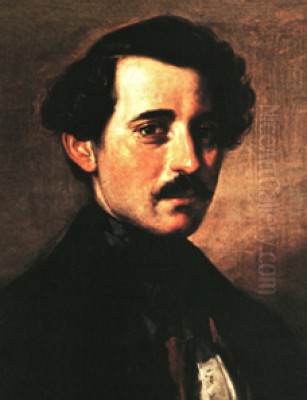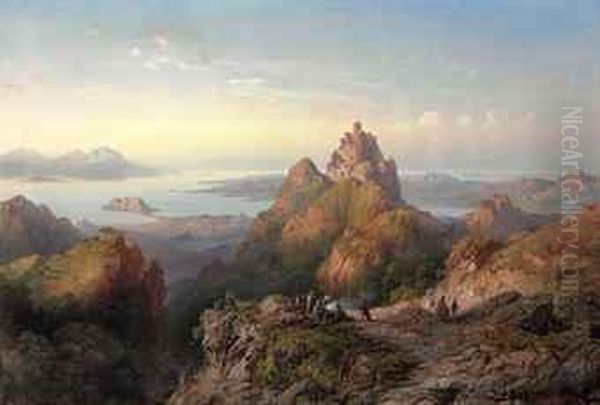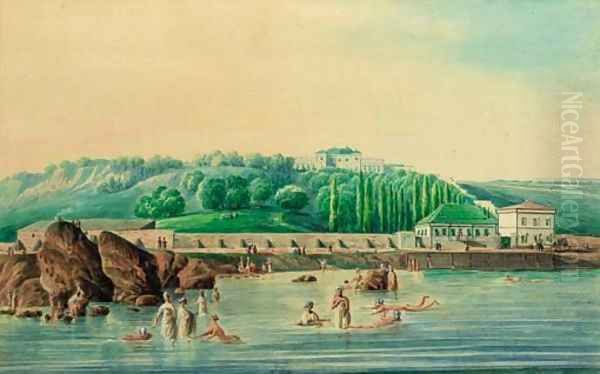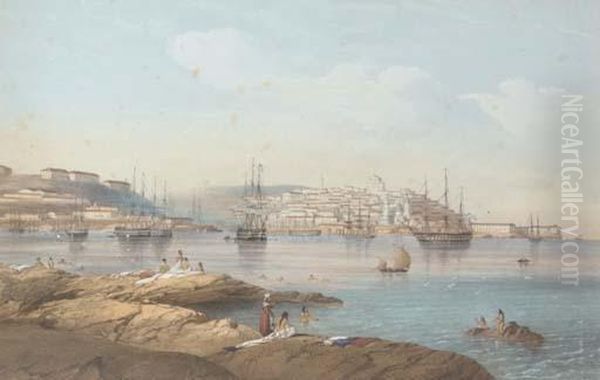
Carlo Bossoli stands as a significant figure in 19th-century European art, a Swiss-born Italian painter and lithographer whose life and work bridged diverse geographical locations and pivotal historical moments. Born in Davesco, near Lugano in Swiss Italy, on December 6, 1815, and passing away in Turin on August 1, 1884, Bossoli carved a unique niche for himself through his masterful depictions of landscapes, historical scenes, cityscapes, and particularly, the tumultuous events of war. His meticulous technique, often employing watercolor and lithography, allowed him to capture breathtaking panoramas and intricate details, leaving behind a visual record that is both artistically compelling and historically invaluable.
Early Life and Russian Beginnings
Bossoli's artistic journey began not in Italy, but in the vibrant Black Sea port of Odessa, then part of the Russian Empire. His family relocated there around 1820 when Carlo was just five years old. His father worked as a stonemason. By 1828, the young Bossoli found employment working for Nannini, a dealer in antiquarian prints, where he likely gained initial exposure to visual arts and printing techniques. His talents soon led him to work as an assistant, and later as a principal designer, for the Odessa Opera, creating stage sets and decorations. This early experience with theatrical design may have influenced his later penchant for dramatic compositions and panoramic perspectives.
During his time in Odessa, Bossoli came into contact with the influential Vorontsov family. Prince Mikhail Vorontsov served as the Governor-General of New Russia and Bessarabia, and his wife, Princess Elizaveta Vorontsova, became a crucial early patron for the aspiring artist. Recognizing his potential, she encouraged his artistic development and, significantly, provided him with the financial means to travel to Italy in 1839 to further his studies. This patronage was instrumental in launching Bossoli's professional career and redirecting his focus towards fine art painting and drawing.
Italian Studies and Artistic Development

Arriving in Italy in 1839, Bossoli immersed himself in the rich artistic environment of Rome and Naples. This period, lasting until 1840, was formative. He dedicated himself to studying painting, focusing particularly on landscape (veduta) and historical subjects. It was during this time that he honed his skills in watercolor and tempera, techniques he reportedly learned from interactions with the community of British artists residing in Italy. The British watercolor tradition, exemplified by masters like J.M.W. Turner and John Sell Cotman, emphasized luminosity, atmospheric effects, and topographical accuracy, elements that would become hallmarks of Bossoli's own style.
His Italian sojourn allowed him to absorb the classical traditions and the burgeoning romantic sensibilities prevalent in the peninsula. While artists like Francesco Hayez in Milan were creating large-scale historical and allegorical paintings steeped in Romantic drama, Bossoli gravitated towards a more observational approach, focusing on capturing the specific character of places and events. He developed a keen eye for architectural detail and the play of light across landscapes, skills that would serve him well throughout his career. His time in Italy solidified his technical foundation and artistic direction, preparing him for the major works that lay ahead.
The Crimean Connection: Landscapes and Conflict
In 1840, Bossoli returned to the Vorontsov estates, particularly Alupka in Crimea. Commissioned by Prince Vorontsov, he embarked on extensive travels throughout the Crimean Peninsula between 1840 and 1842. This period was incredibly productive, resulting in numerous sketches, watercolors, and paintings depicting the region's stunning natural beauty, diverse architecture, and historical sites. He captured the dramatic coastline, the mountainous interior, and the unique cultural blend of the peninsula with remarkable fidelity. Works like The Towers of Bakhchisaray, depicting the ancient capital of the Crimean Khanate, showcase his ability to blend picturesque scenery with precise architectural rendering.
Bossoli's deep familiarity with Crimea proved invaluable with the outbreak of the Crimean War (1853-1856). Although he had left Russia by this time, settling in Turin in 1853, his earlier works provided a unique visual resource. He capitalized on the intense public interest in the conflict, particularly in Britain. In 1856, the London publishers Day & Son released his most famous series of lithographs: Beautiful Scenery and Chief Places of Interest throughout the Crimea. This collection comprised 52 plates, often hand-colored, based on his earlier drawings and watercolors.

The publication was a resounding success. It offered the British public, hungry for information about the distant war theatre, detailed and evocative views of places frequently mentioned in news reports but rarely seen. The series was highly praised for its accuracy and artistry, earning the admiration of Queen Victoria and Prince Albert, who acquired a set. Works like his panoramic depiction of Balaklava, the site of the infamous Charge of the Light Brigade, provided a sense of place that journalistic accounts alone could not convey. While artists like William Simpson and Constantin Guys were acting as 'special artists' reporting directly from the front lines for publications such as the Illustrated London News (to which Bossoli also contributed illustrations), Bossoli's work offered a more comprehensive, pre-war perspective on the landscape itself, imbued with a sense of historical depth. His detailed topographical style can be compared to the work of other travelling artists like David Roberts, known for his views of the Near East, though Bossoli focused intensely on this specific region. His Crimean work contrasts sharply with the dramatic, often turbulent Crimean seascapes of his Russian contemporary, Ivan Aivazovsky.
Chronicler of the Risorgimento
Having settled in Turin, the capital of the Kingdom of Sardinia-Piedmont, Bossoli found himself at the heart of the unfolding drama of Italian unification, the Risorgimento. His skills in depicting historical events and landscapes were soon called upon again. Following the Second Italian War of Independence in 1859, a pivotal conflict in the unification process, Bossoli was commissioned, likely by Prince Eugene of Savoy-Carignano, to document the campaign.
He followed the Piedmontese army, witnessing firsthand the key battles and troop movements. This resulted in an extraordinary series of around 150 vivid watercolors (though some sources mention oil paintings) depicting the events of 1859, 1860, and 1861. These works captured not only the major battles like the Battle of Solferino and the Battle of Magenta Bridge but also marches, encampments, and logistical aspects of the war, providing a remarkably comprehensive visual narrative. His dedication and the perceived accuracy of his work earned him the prestigious title of "Pittore storico della campagna di guerra" (Historical Painter of the War Campaign), essentially making him an official war artist.
Many of these images were subsequently used to illustrate the book The War in Italy, published in London in 1860 by Day & Son, with text provided by the correspondent for The Times. This publication further cemented Bossoli's reputation internationally as a chronicler of contemporary history. His approach to these battle scenes differed from the heroic idealization often found in the work of earlier Romantic painters like Théodore Géricault or Eugène Delacroix. While dramatic, Bossoli's depictions maintained a strong sense of topographical accuracy and reportorial detail, focusing on the disposition of troops and the landscape of battle. This aligns him more closely with the tradition of military art focused on documentation, though his work retains a distinct artistic sensibility. His detailed focus contrasts with the broader, more atmospheric approach of some Macchiaioli painters like Giovanni Fattori, who also depicted scenes from the Risorgimento but often with a greater emphasis on the lives of ordinary soldiers and a more 'impressionistic' technique.
Artistic Style and Technique

Carlo Bossoli's artistic style is characterized by several key features. Foremost among these is his mastery of the panoramic view (veduta). Whether depicting a sprawling cityscape like his Panorama of Constantinople (1854) or a complex battle scene, he excelled at capturing wide vistas with a remarkable sense of depth and spatial coherence. This likely stemmed from his early work in theatre design and was refined through his extensive landscape studies.
His work is grounded in realism, particularly in its attention to topographical and architectural detail. He possessed a keen observational skill, meticulously rendering buildings, terrain, and even small elements like figures, boats, or military equipment. This accuracy lent his historical and landscape works a documentary quality highly valued by his contemporaries. However, his realism was often tempered with a romantic sensibility. He chose viewpoints that emphasized the picturesque or dramatic aspects of a scene, and his use of light and color, while naturalistic, often served to enhance the mood and atmosphere.
Bossoli was particularly adept with watercolor and gouache (an opaque watercolor). He exploited the transparency and luminosity of watercolor to capture subtle atmospheric effects and the brilliance of Mediterranean or Crimean light. His lithographic series, such as the Crimean views and the Italian War illustrations, demonstrated his ability to translate his detailed drawings into printable images suitable for wider dissemination. These prints, often enhanced with hand-coloring, brought his work to a broad audience across Europe. His technical proficiency allowed him to work effectively both on intimate sketches and large-scale, detailed compositions.
Travels and Wider Horizons
While Crimea and Italy were central to Bossoli's career, his artistic curiosity led him further afield. He travelled extensively throughout his life, seeking new subjects and landscapes. His journeys took him to various parts of Italy beyond Rome and Naples, including Sicily, as evidenced by works like Il Golfo di Palermo dalle Mura delle Cattive (The Gulf of Palermo from the Walls of the Cattive, 1880). He also ventured into France, Spain, and notably, Morocco.

His travels extended to the Ottoman Empire, resulting in works like the aforementioned Panorama of Constantinople and The Dardanelles Strait. These paintings reflect the 19th-century European fascination with the 'Orient', though Bossoli's approach remained largely focused on topographical and architectural representation rather than the more ethnographic or romanticized visions of Orientalist painters like Jean-Léon Gérôme or Eugène Delacroix. These journeys broadened his repertoire and provided him with diverse material, showcasing his ability to adapt his style to different environments and cultures. His painting Alle Porte di Balangero (At the Gates of Balangero, 1880), depicting a scene likely near Turin, shows his continued engagement with local Italian landscapes later in his life.
Interaction with Contemporaries and Recognition
Bossoli's career intersected with numerous figures in the art world and beyond. His early patronage by the Vorontsov family in Russia was crucial. His time in Italy brought him into contact with the expatriate British art community, influencing his technique. His success with the Crimean lithographs brought him to the attention of the British monarchy, Queen Victoria and Prince Albert, signifying significant recognition. The commission related to the Italian Wars of Independence connected him directly with the Savoyard monarchy and military establishment, notably Prince Eugene of Savoy-Carignano.
While direct records of close friendships with specific major painters are scarce, his work existed within the broader context of 19th-century European art. His detailed topographical style found parallels in the work of artists like David Roberts. His role as a war artist can be compared to contemporaries like William Simpson and Constantin Guys covering the Crimean War, or Horace Vernet in France known for large-scale battle paintings. In Italy, his career overlapped with the rise of the Macchiaioli (Giovanni Fattori, Telemaco Signorini, Silvestro Lega), who offered a radically different, anti-academic approach focused on capturing fleeting impressions of light and everyday life, often using a distinctive 'spot' or 'macchia' technique. Bossoli's more traditional, detailed style set him apart from this avant-garde movement, yet his depictions of the Risorgimento provide an important counterpoint to their interpretations of the same historical period. His work was known and appreciated by collectors and the public, particularly through widely circulated prints.
Legacy and Enduring Importance
Carlo Bossoli's legacy rests on his dual role as a skilled artist and a valuable historical chronicler. His extensive body of work provides a unique visual record of diverse locations across Europe, North Africa, and the Near East during a period of significant change. His depictions of Crimea offer precious insights into the region before and during the Crimean War, while his paintings and illustrations of the Italian Wars of Independence are among the most comprehensive visual accounts of the Risorgimento campaigns.
His mastery of the panoramic landscape and his meticulous attention to detail made him one of the foremost veduta painters of his generation. His technical skill, particularly in watercolor and lithography, was widely recognized. Today, his works are held in important collections, including the Museo Civico d'Arte Antica (Palazzo Madama) and the Museo Nazionale del Risorgimento Italiano in Turin, which houses many of his Italian War watercolors. His paintings continue to be sought after by collectors and admired for their blend of accuracy, artistry, and historical significance. He remains an important figure for understanding 19th-century landscape painting, topographical art, and the visual culture surrounding major European conflicts.
Unanswered Questions and Anecdotes
Despite his productivity and recognition, aspects of Bossoli's life and work remain subjects of discussion or mystery. For instance, details surrounding a series of lithographs depicting Chisinau (Kishinev), reportedly made around 1841-1842, are unclear, with some locations unidentified and works potentially lost. The precise condition and conservation history of the large set of Risorgimento watercolors have also been debated among scholars.
Furthermore, the motivations behind some of his later artistic choices, such as an apparent increased interest in nocturnal scenes like the Panorama of the Bosphorus by Night, are not fully understood. Were these driven by artistic exploration, market demand, or personal inclination? Similarly, while sketches of sites like the towers and palaces of Bakhchysarai are mentioned in relation to his Crimean travels, the full extent and purpose of these studies may not be completely documented or accessible. These minor enigmas add a layer of intrigue to the study of an artist whose primary legacy is one of clarity and detailed observation.
Conclusion
Carlo Bossoli navigated the complex currents of 19th-century Europe, translating its landscapes, cities, and conflicts into compelling visual narratives. From the shores of the Black Sea to the battlefields of Italy, his brush and lithographic crayon captured moments of profound historical change and scenes of enduring natural beauty. His Swiss origins, Russian formative years, and Italian career created a unique trajectory, reflected in the breadth of his subject matter. As a master of the panorama, a meticulous observer, and a skilled technician in watercolor and printmaking, Bossoli secured his place as a significant artist of his time. His work continues to offer invaluable insights for art historians and historians alike, providing a window onto the world of the 19th century through the eyes of a remarkably perceptive and diligent chronicler.